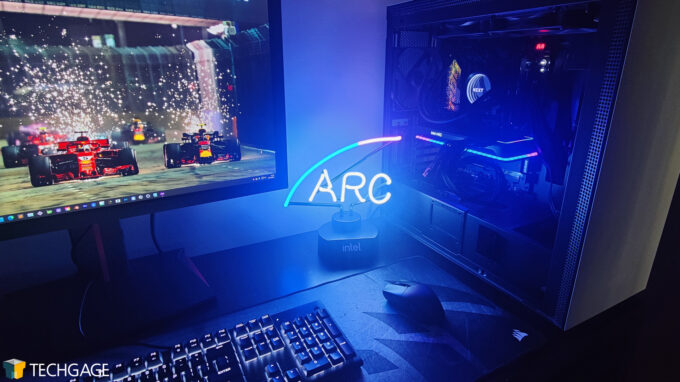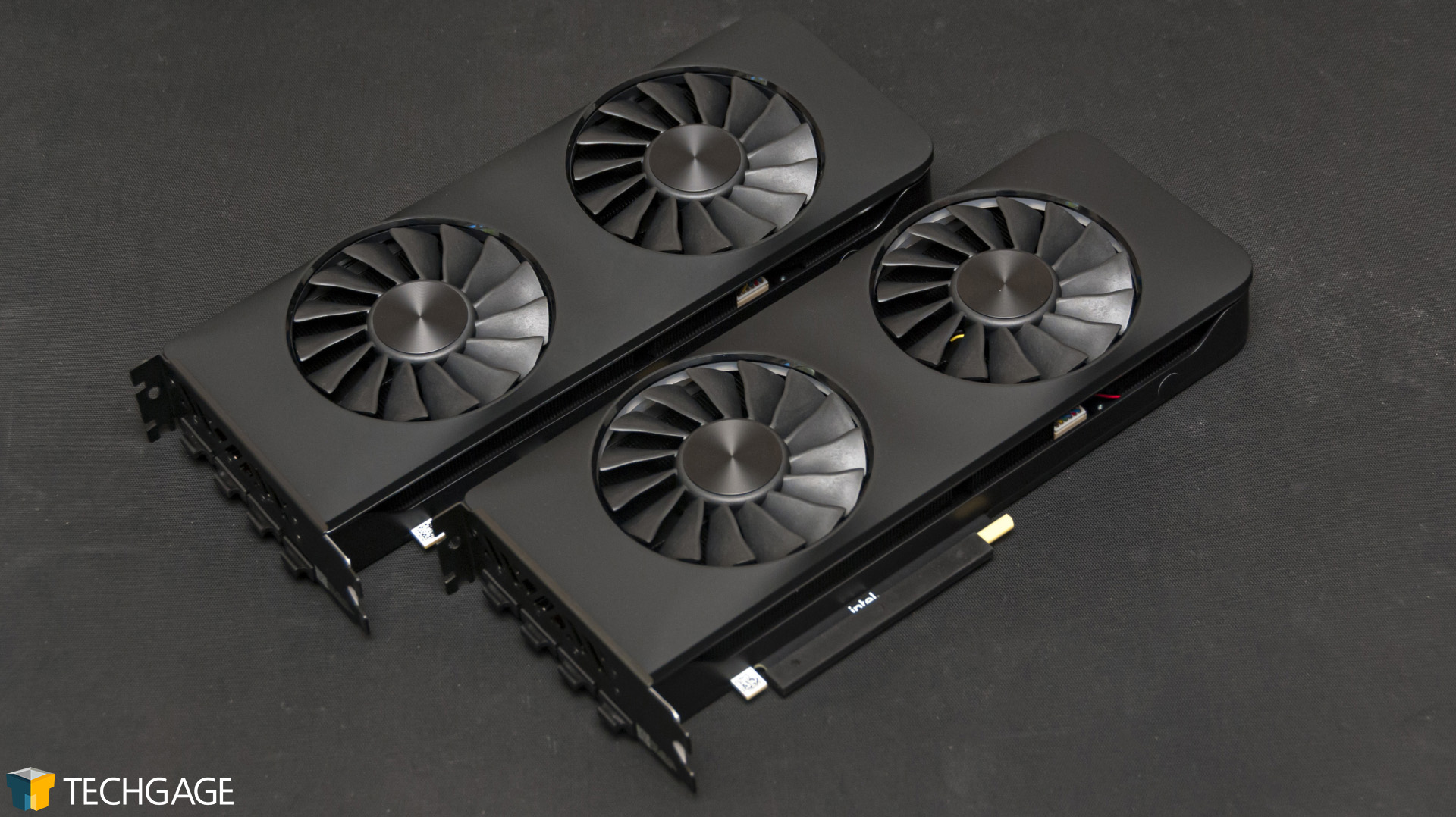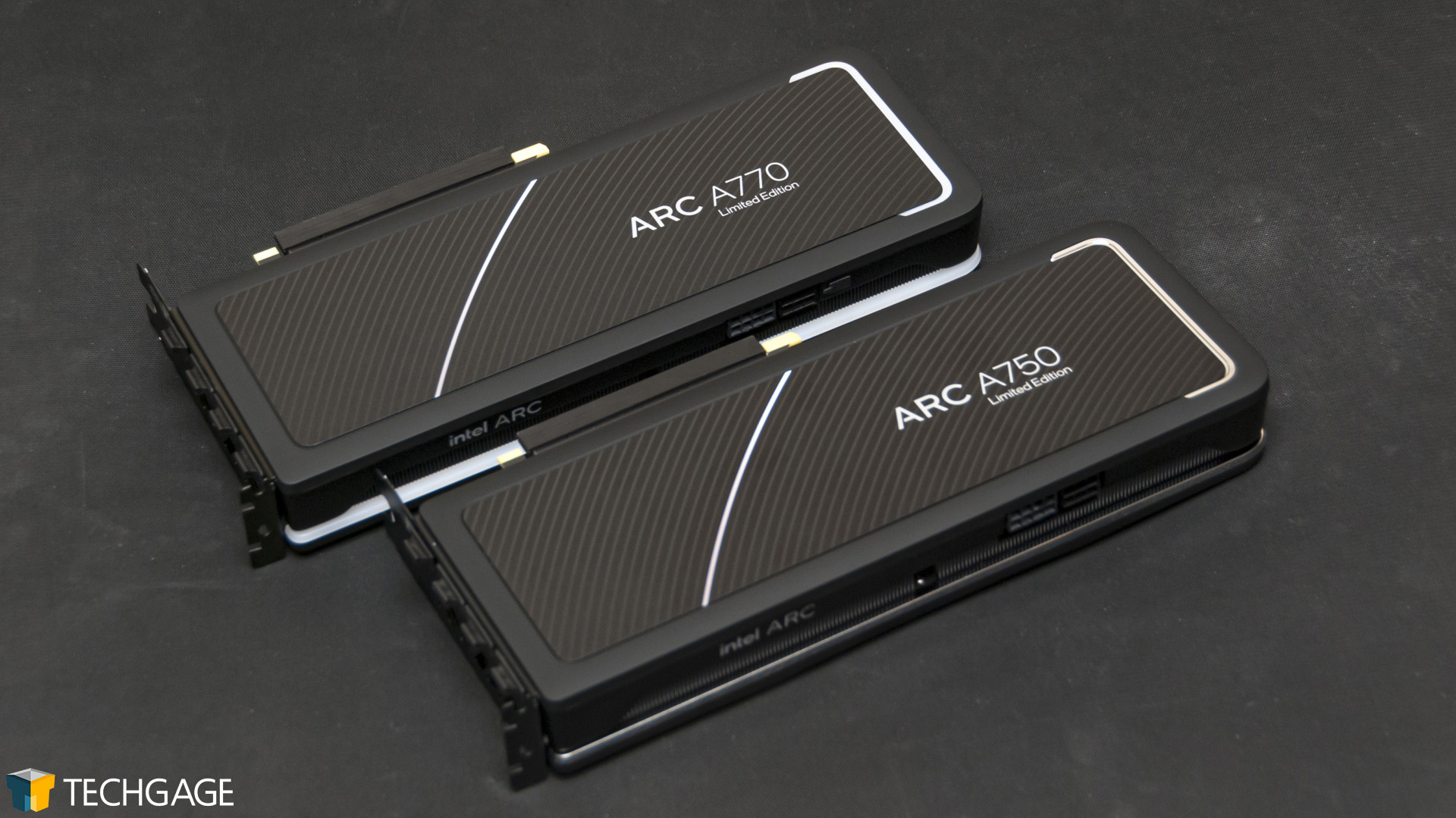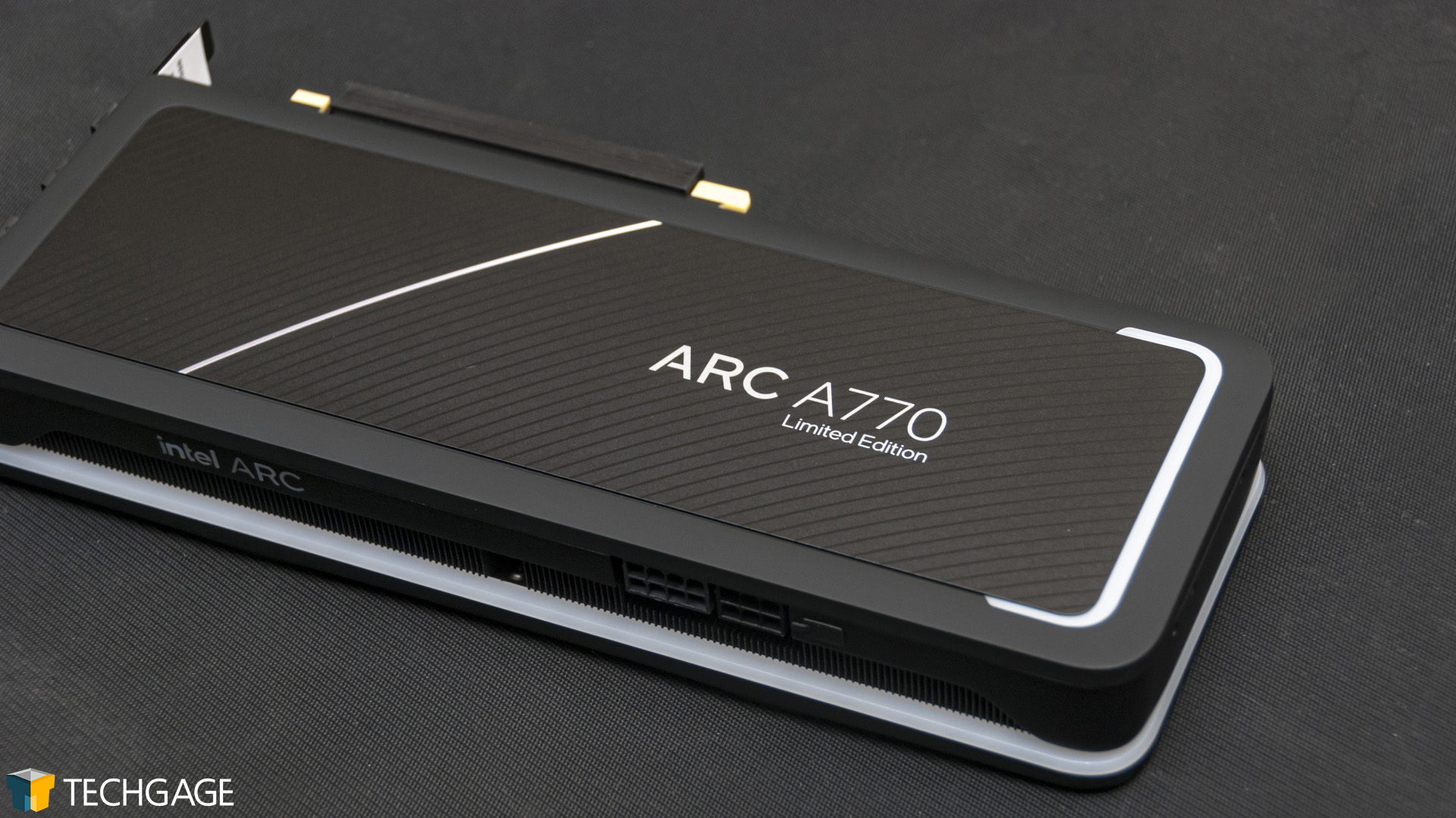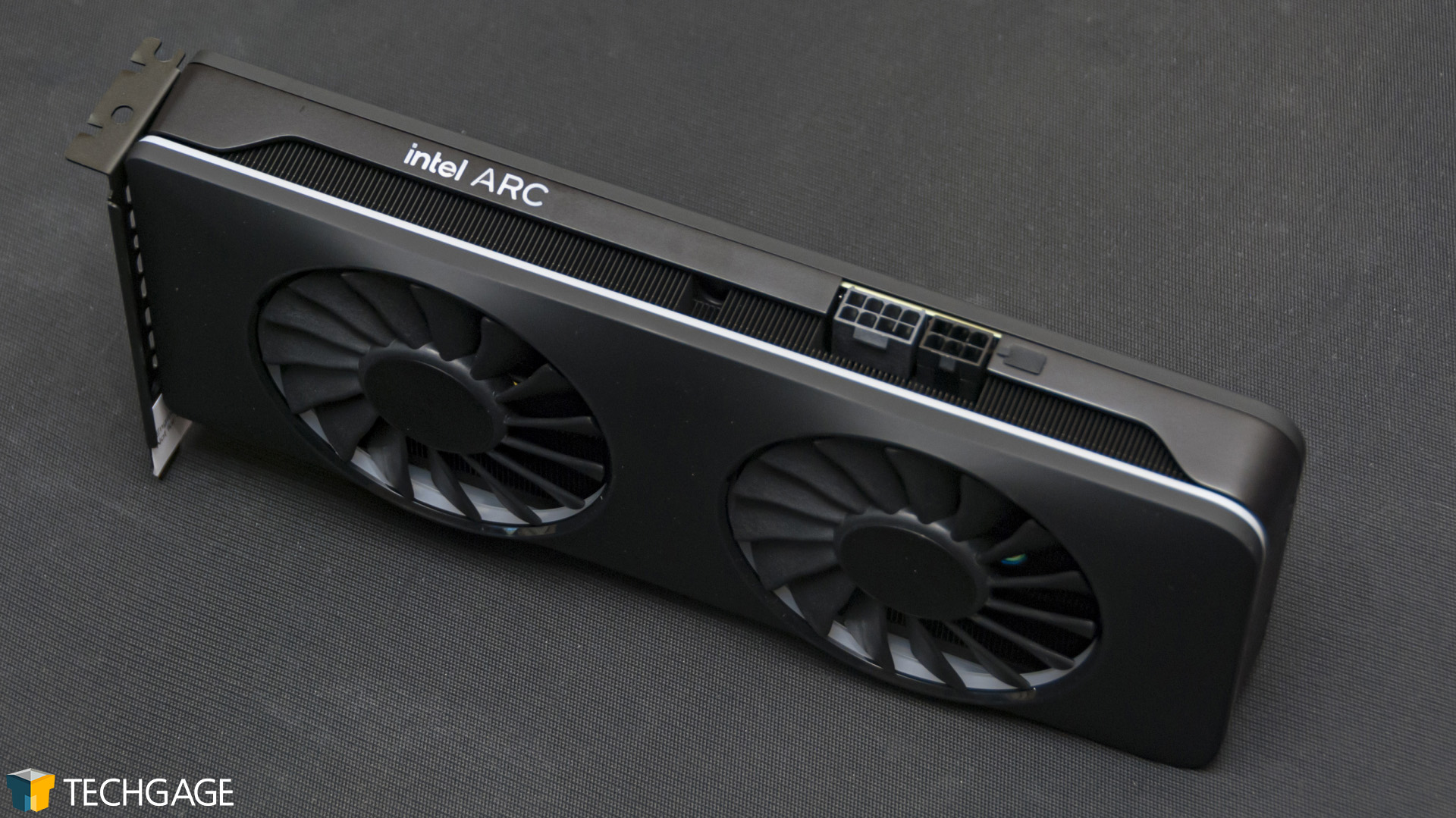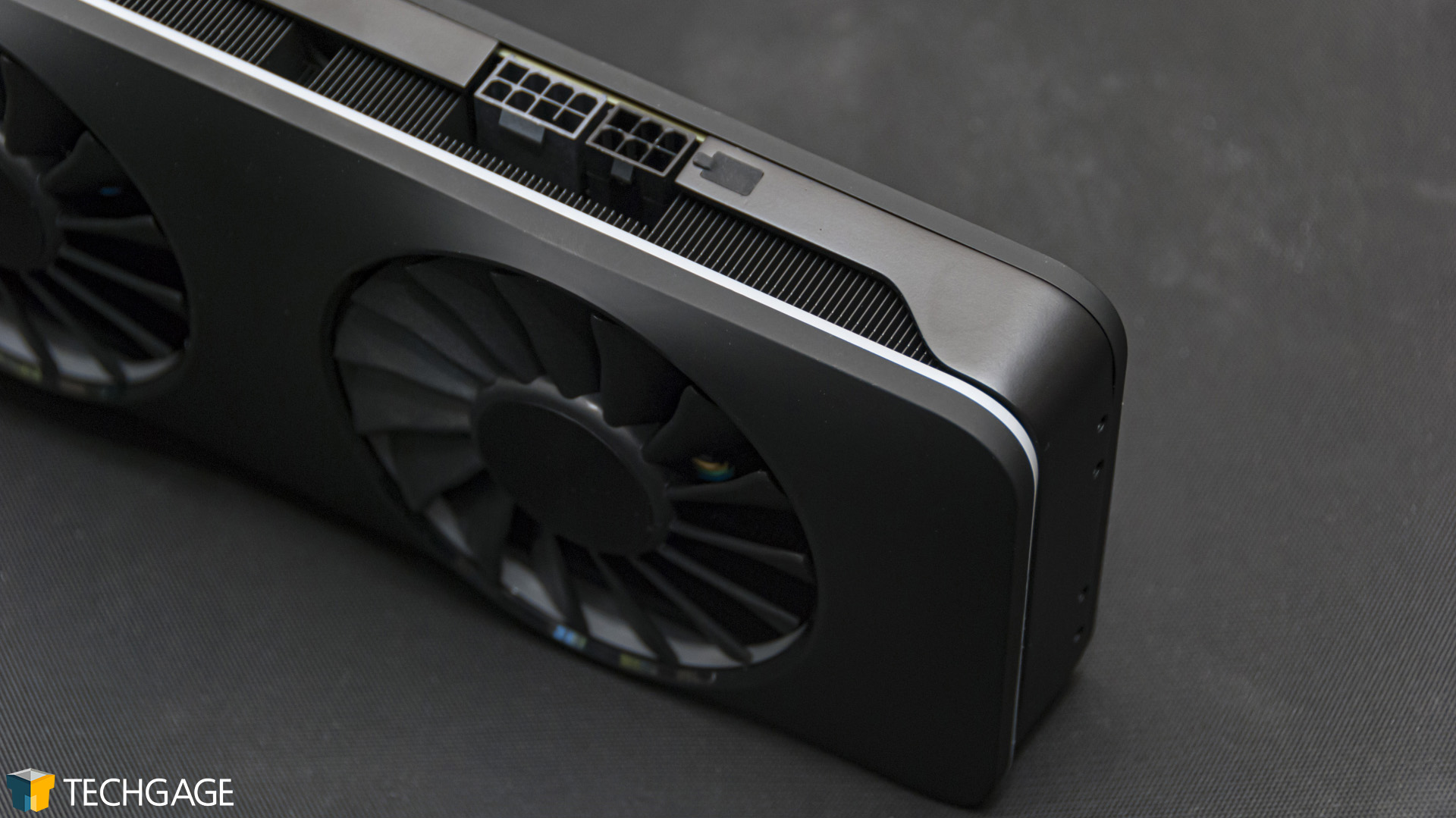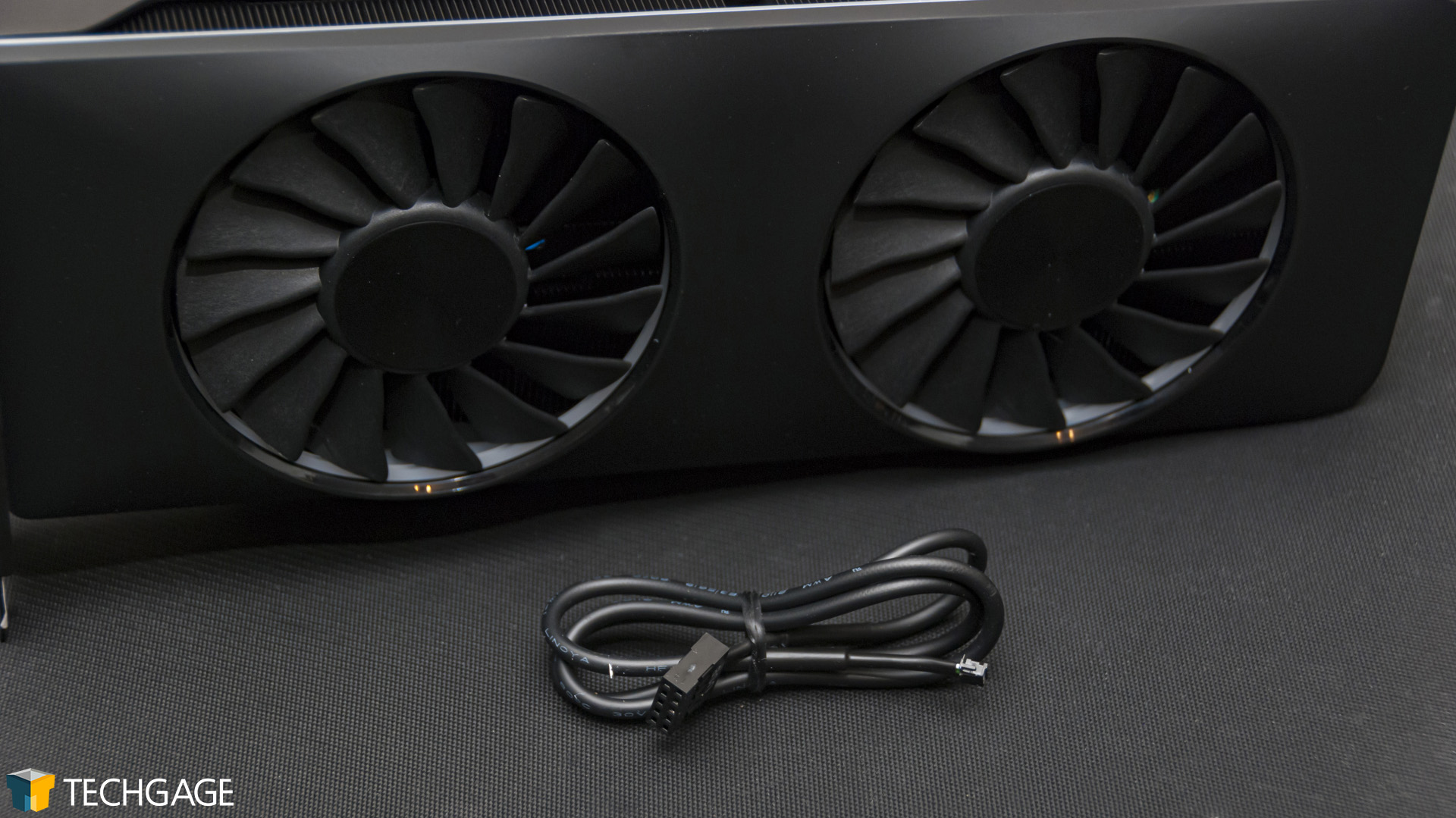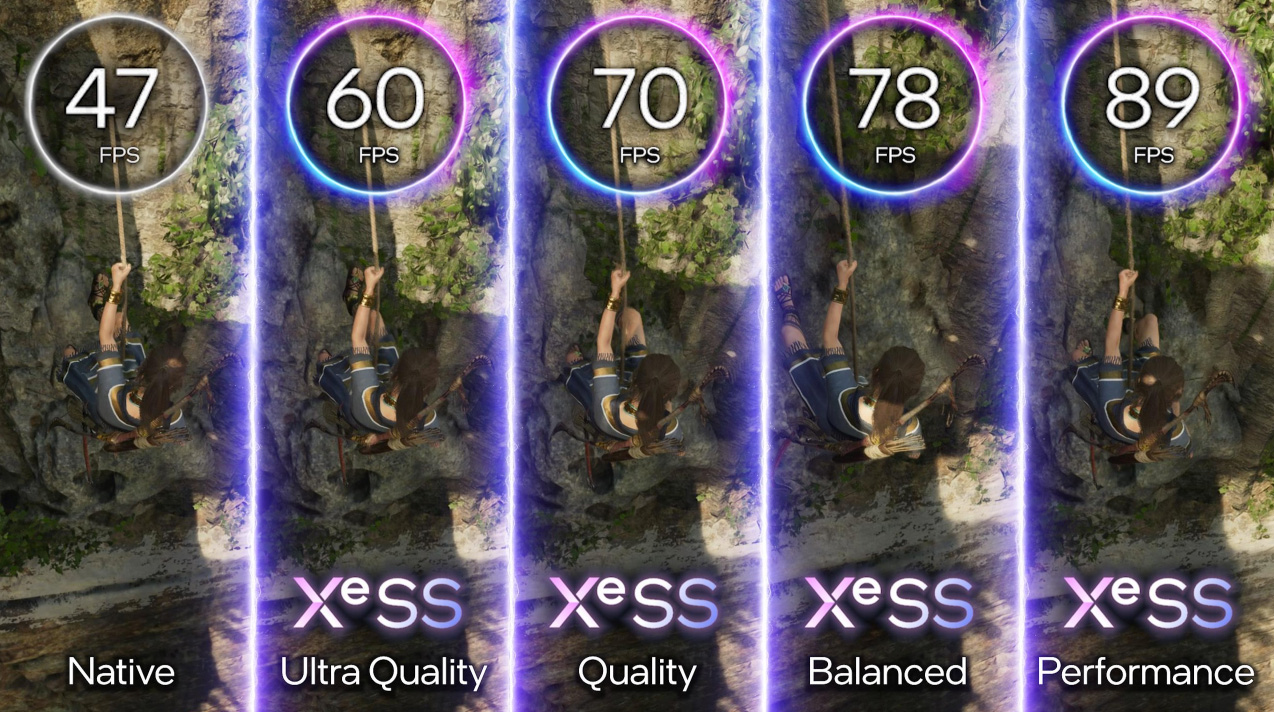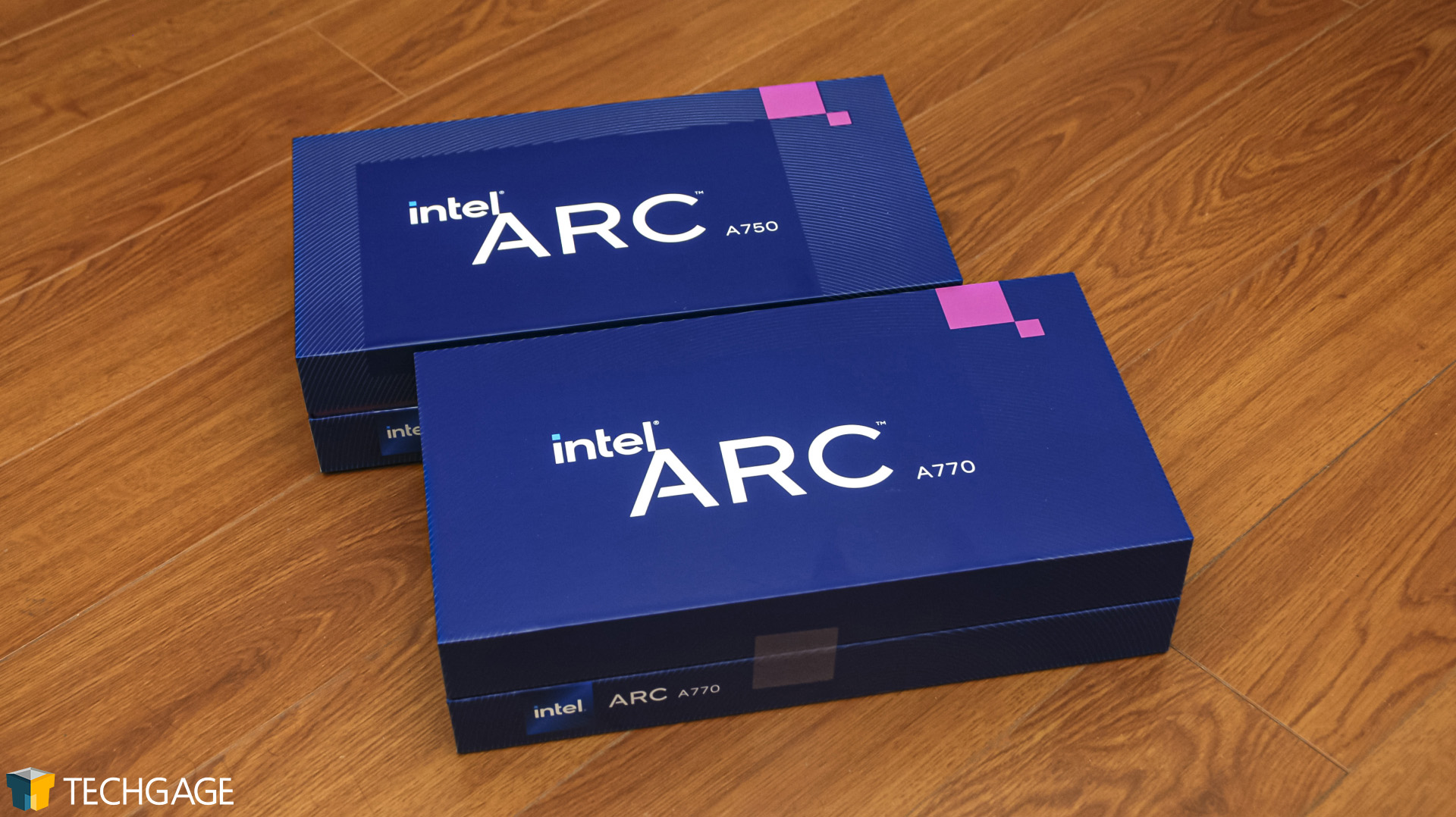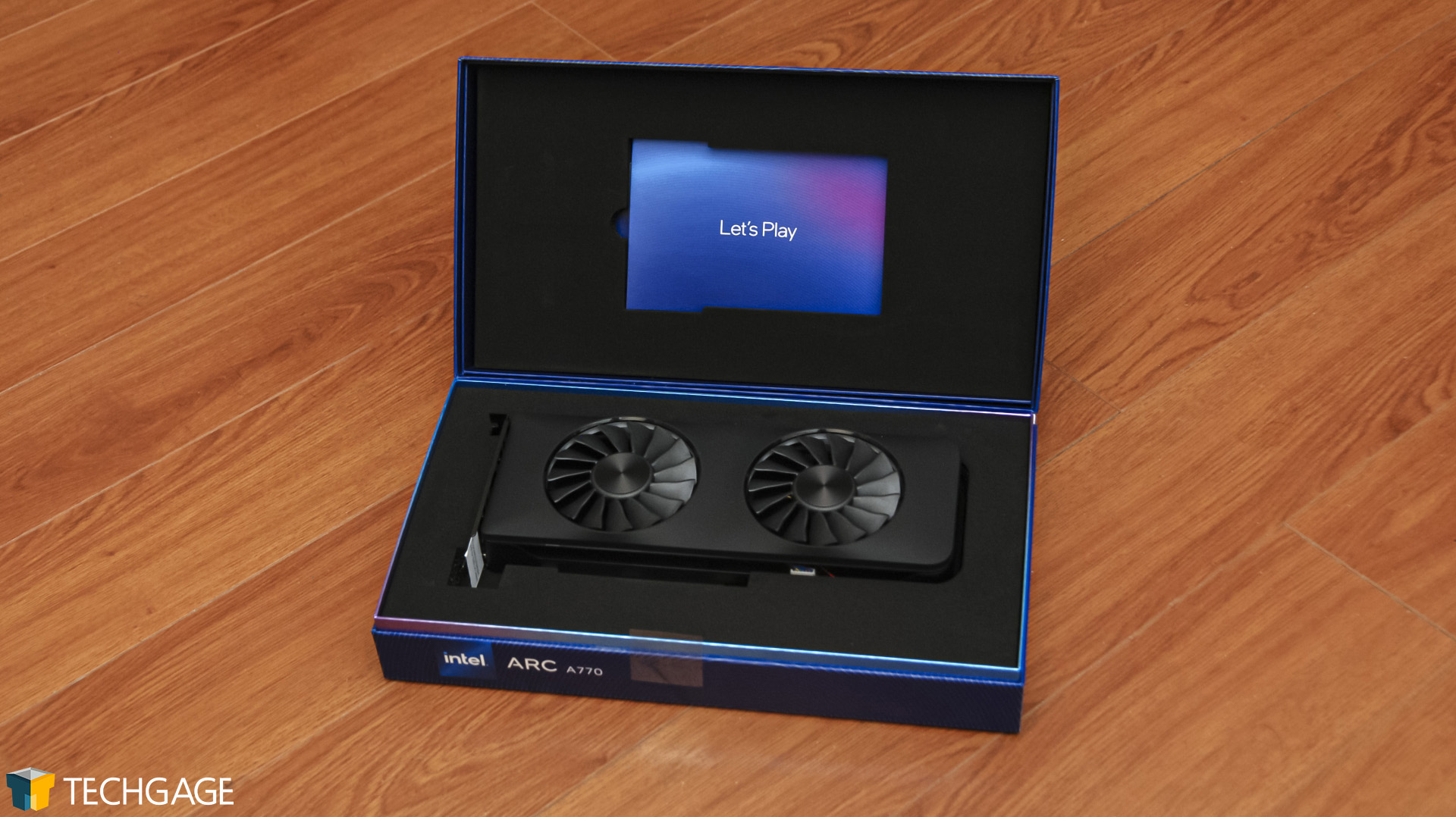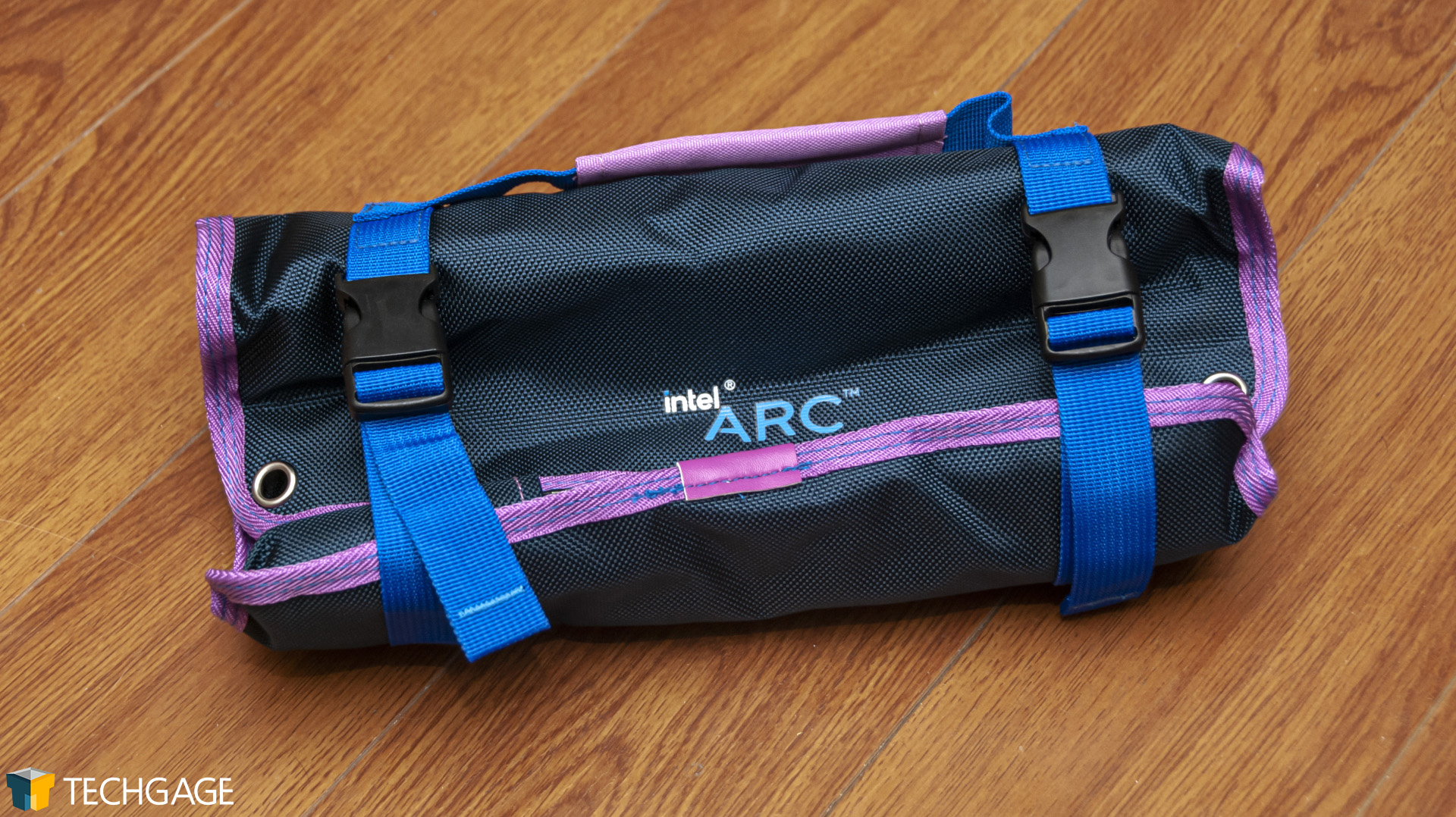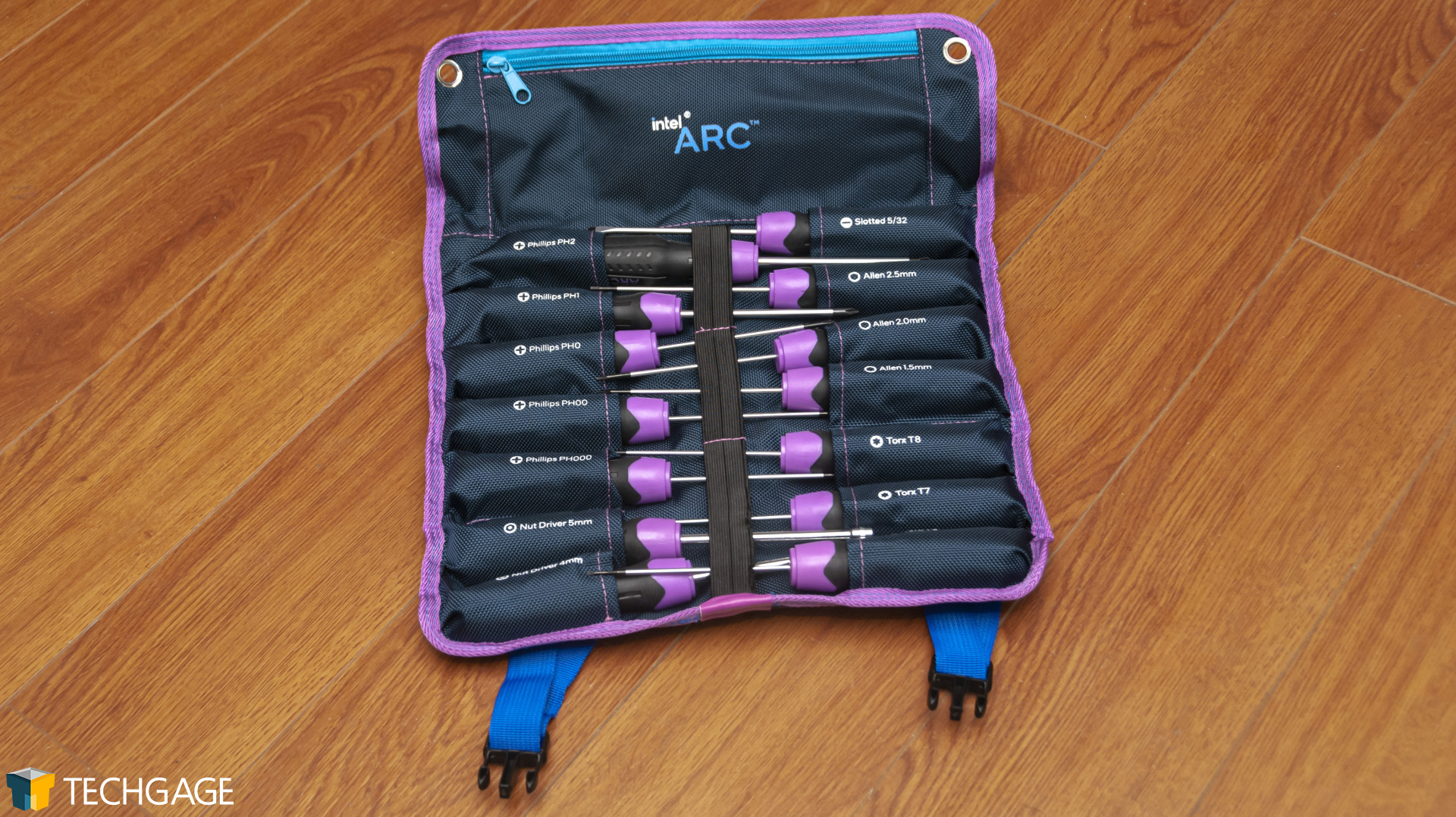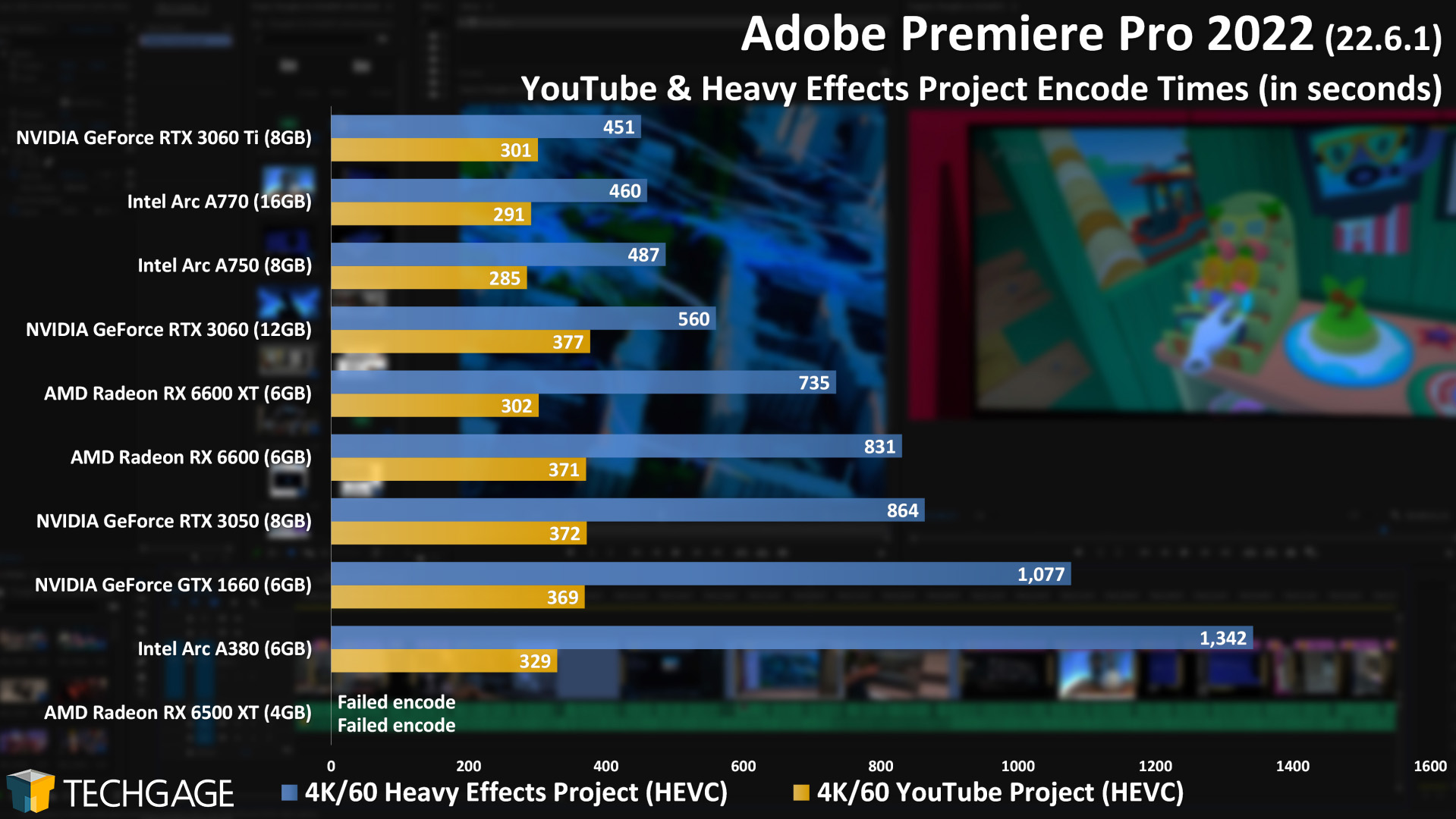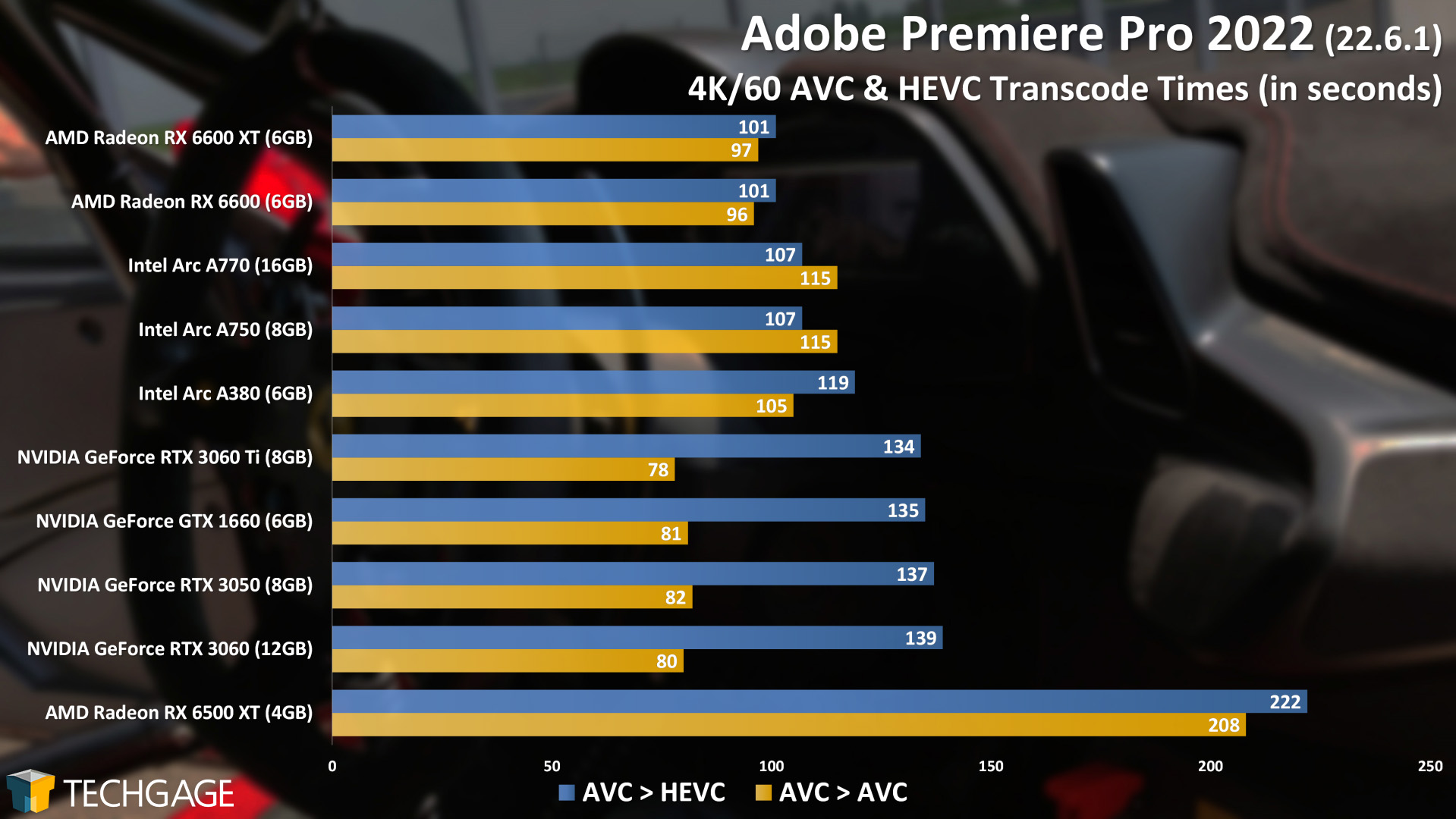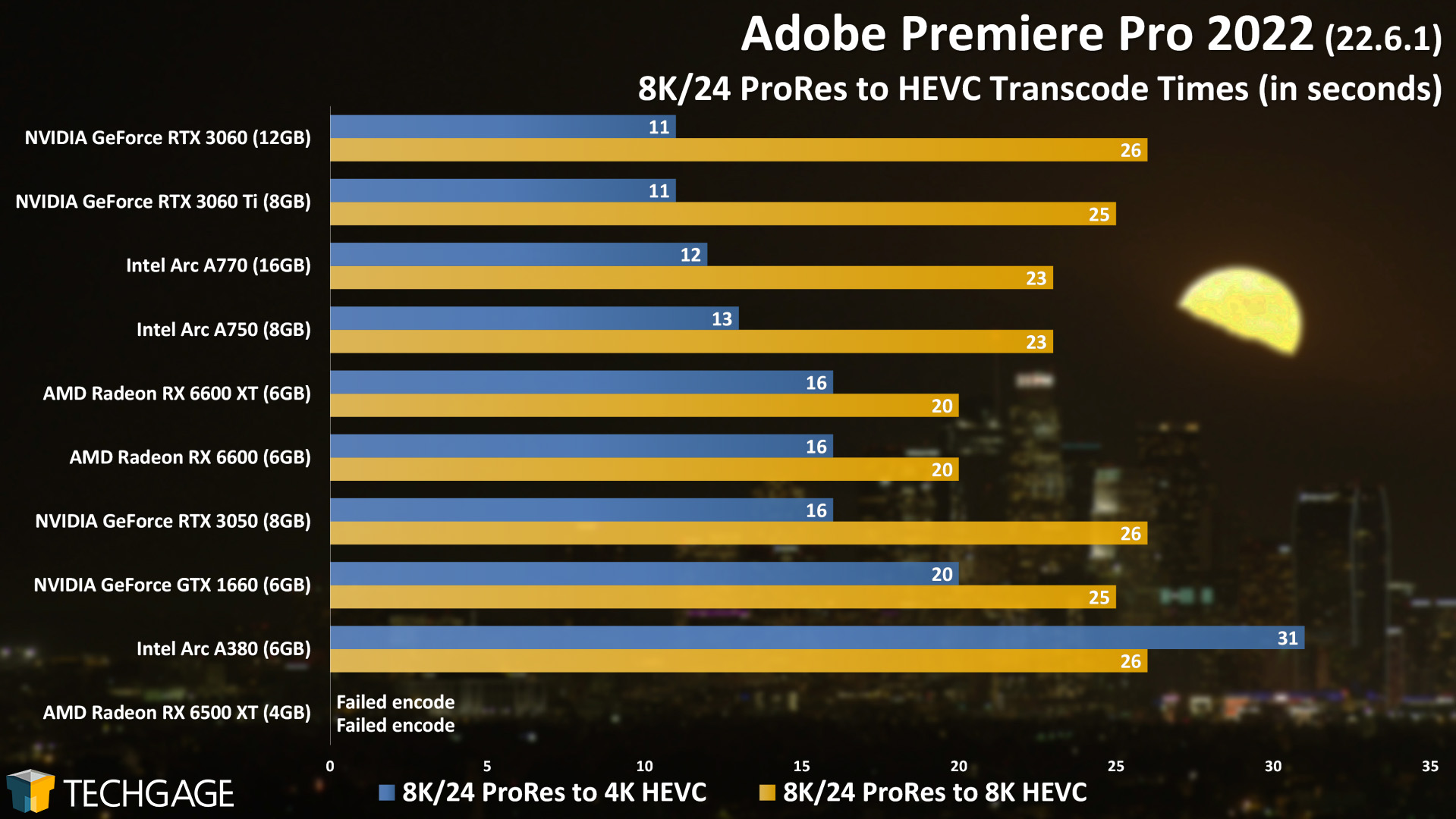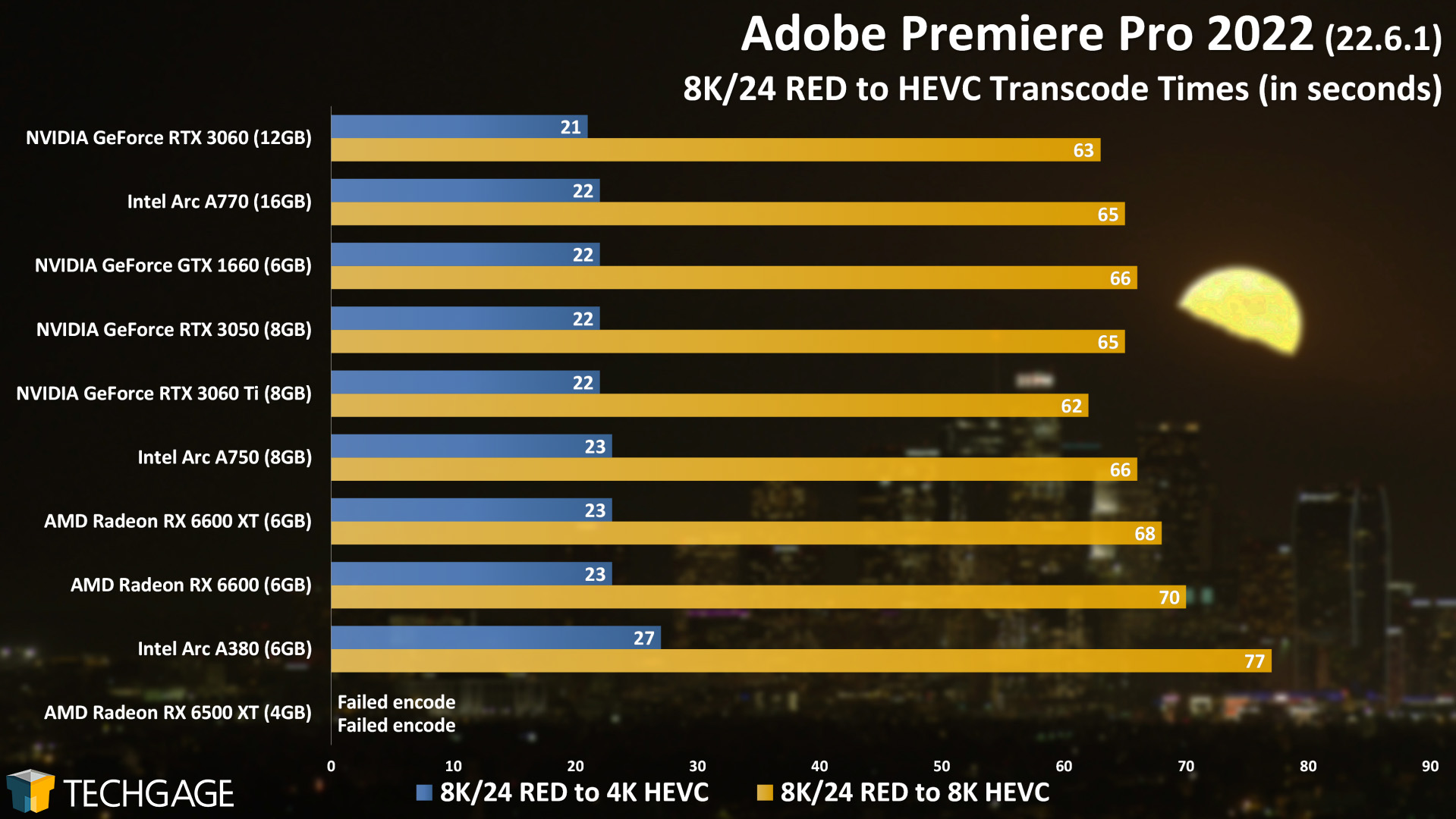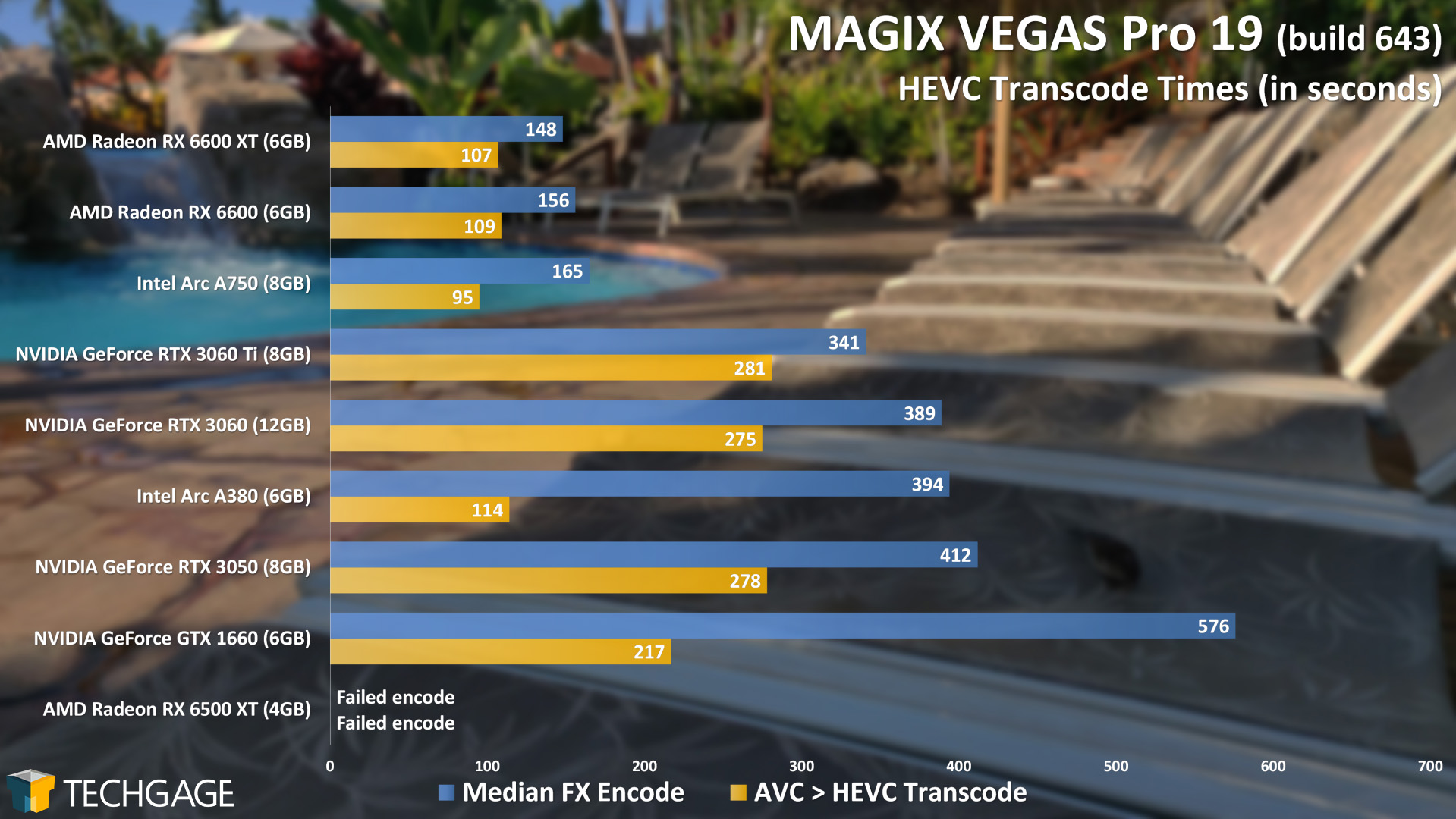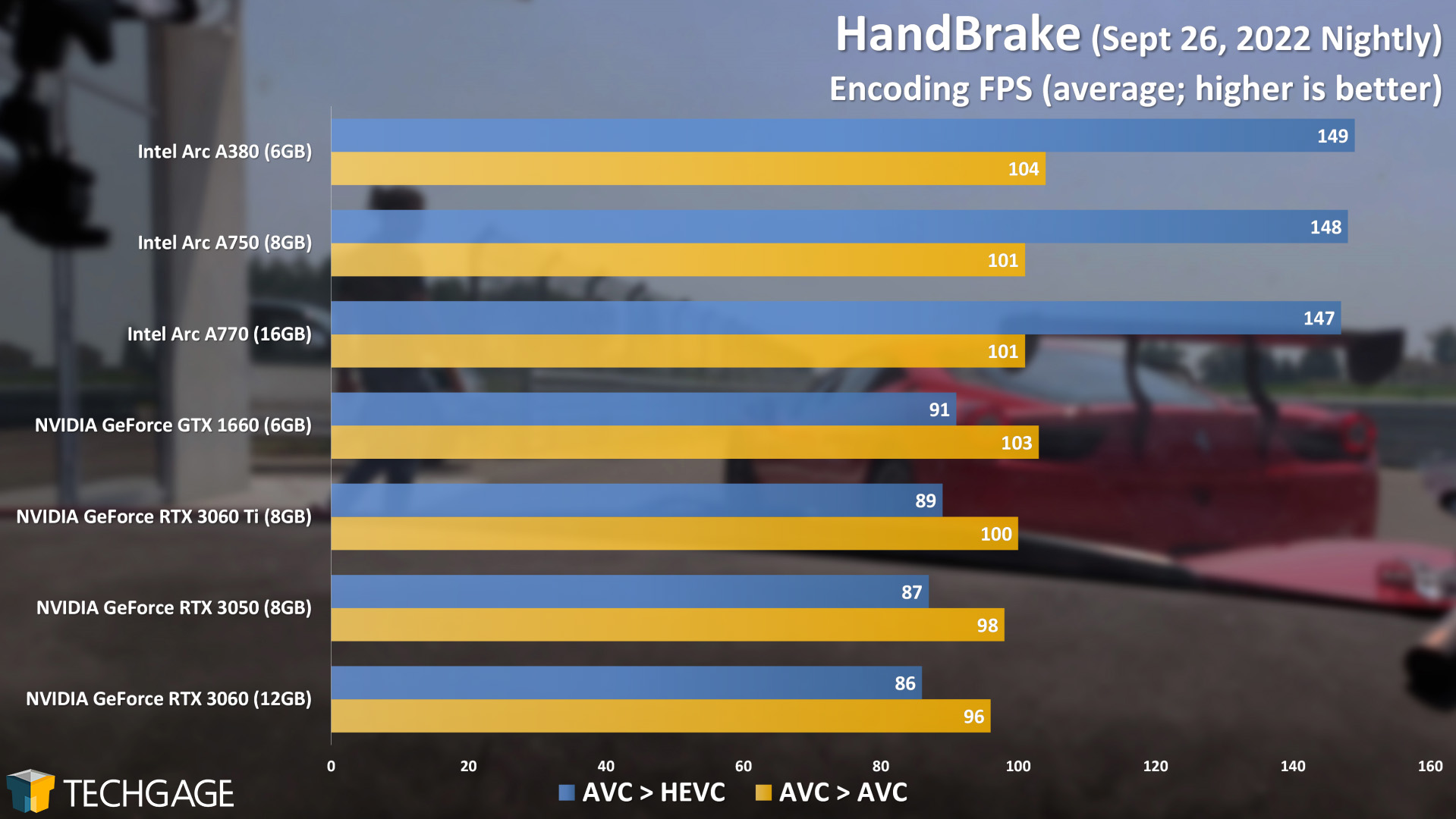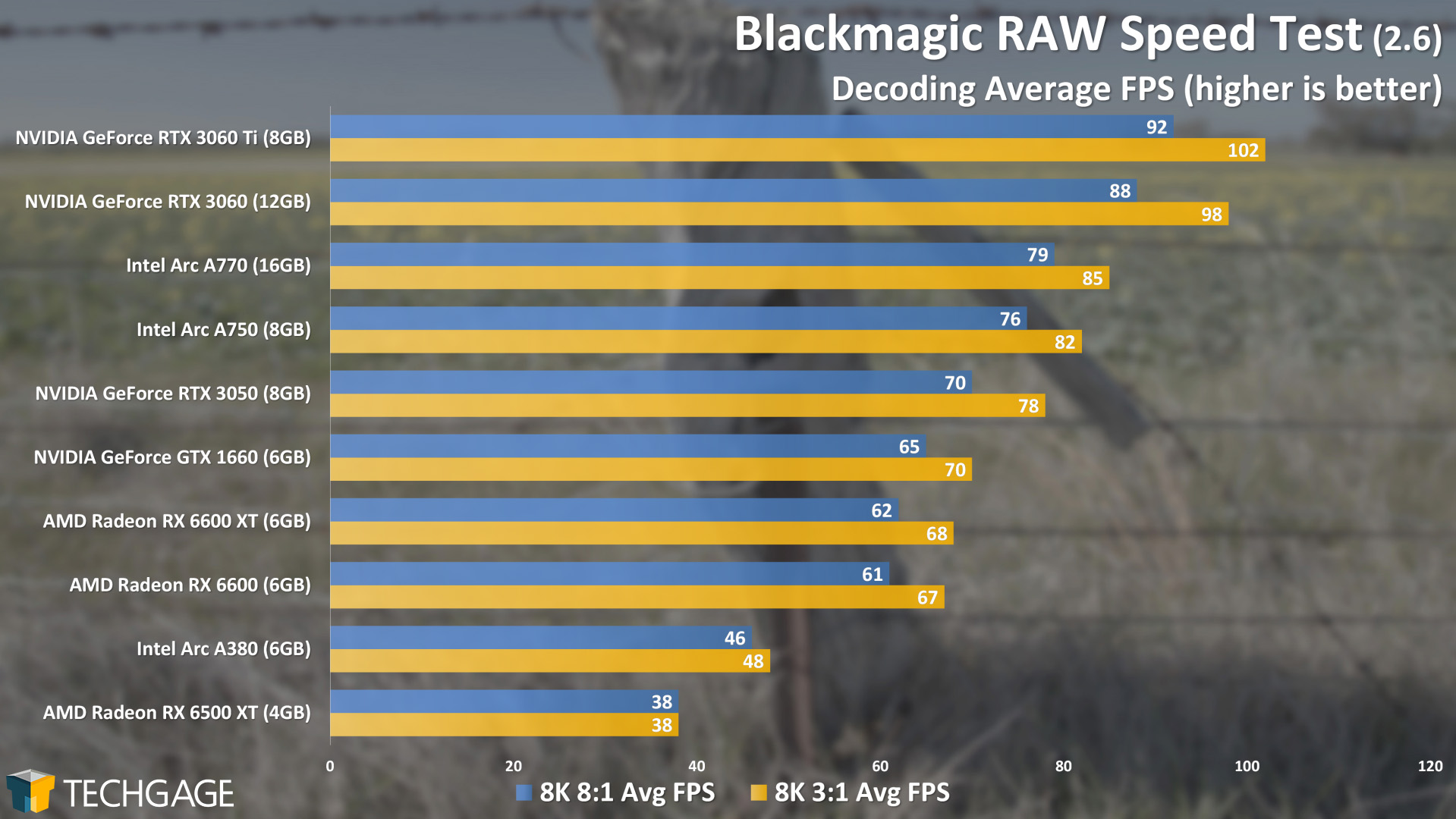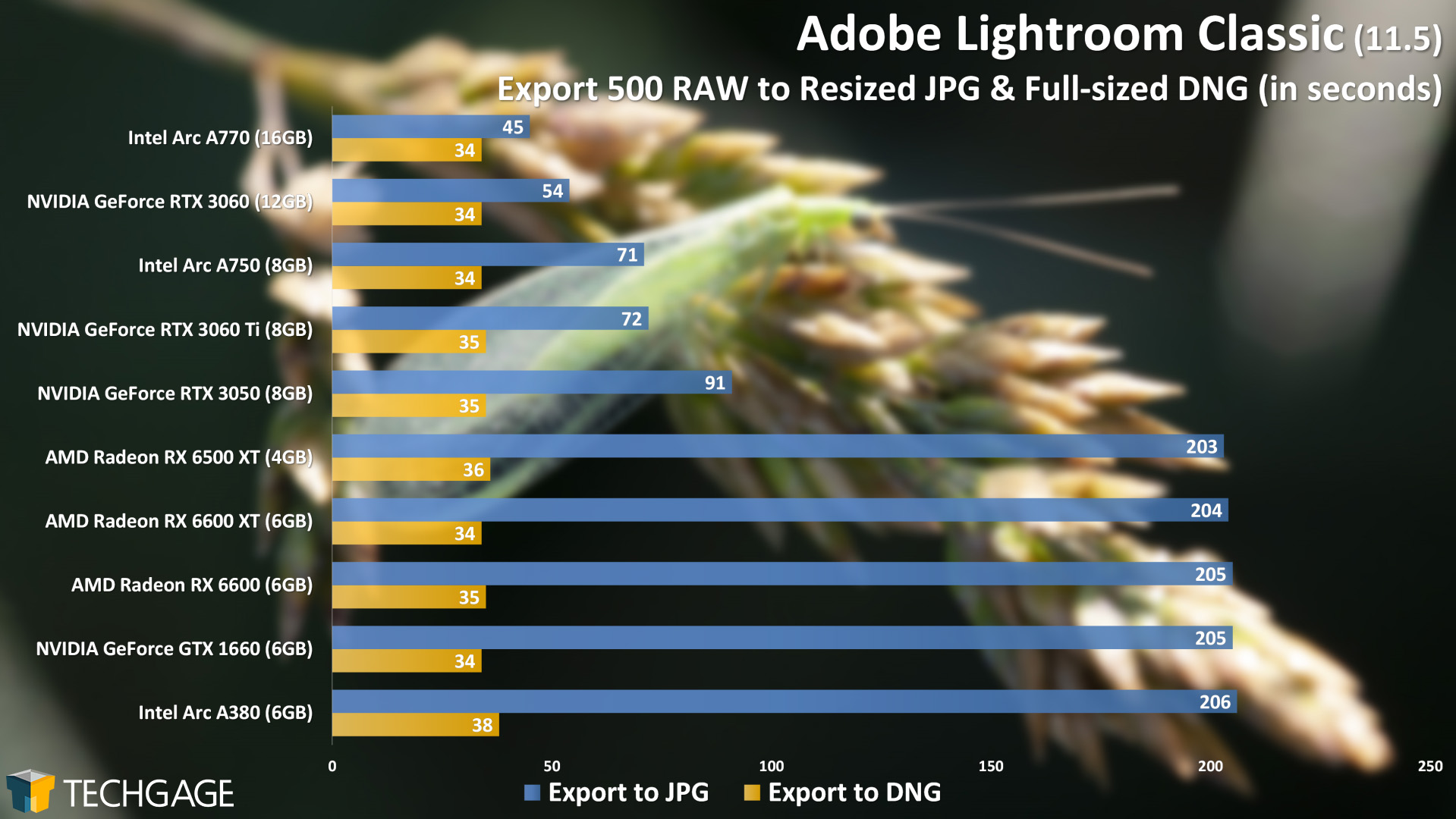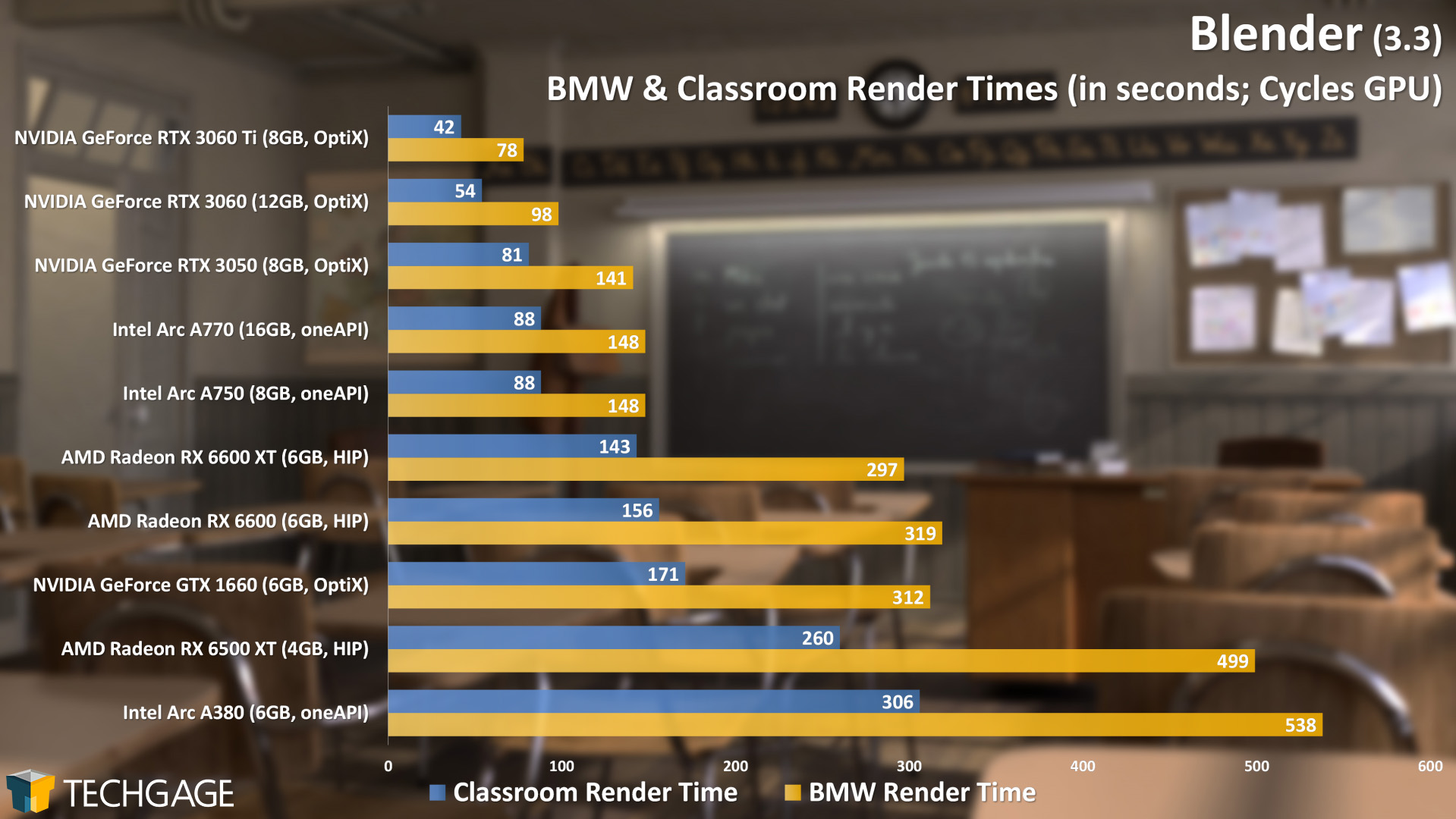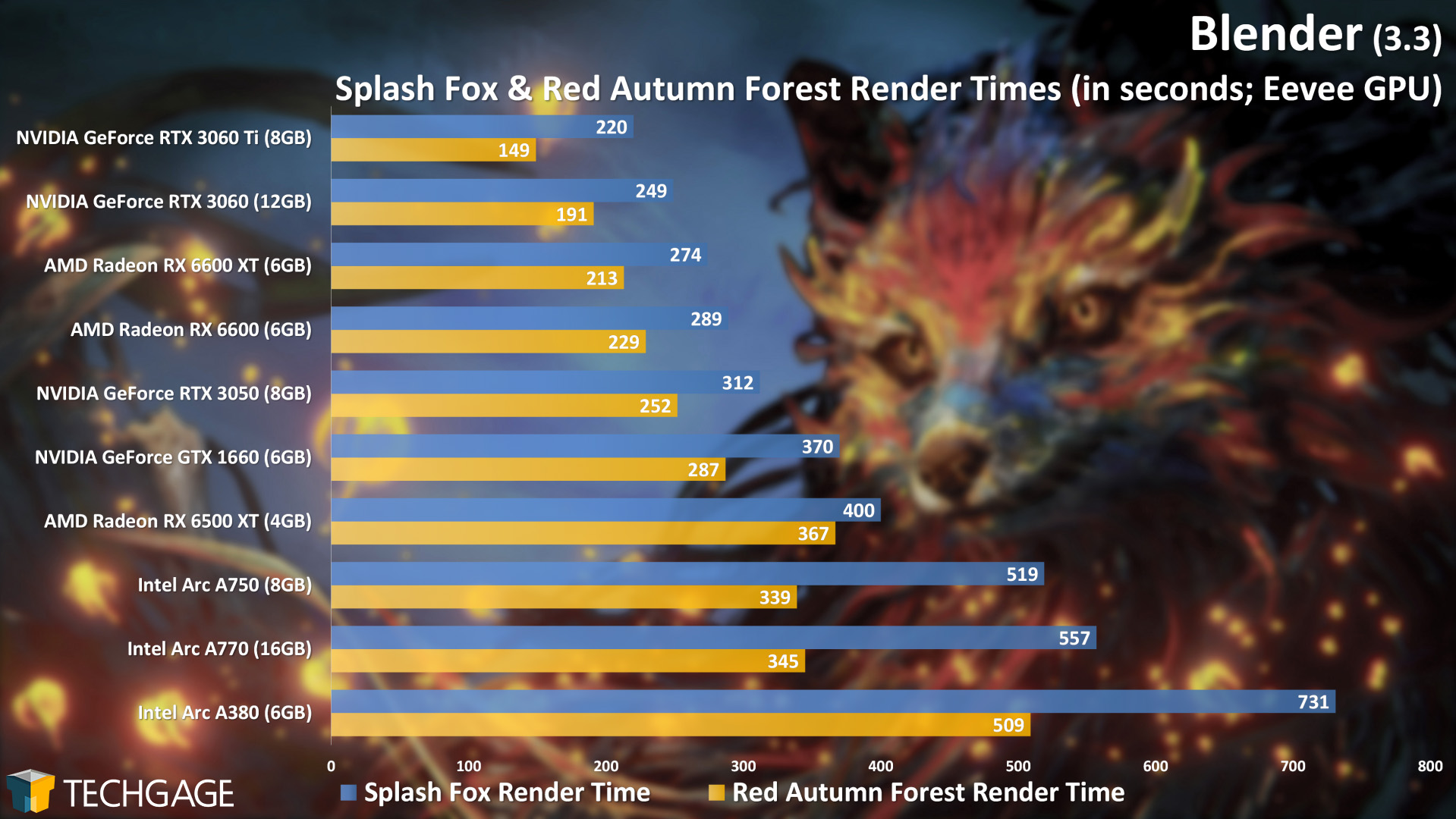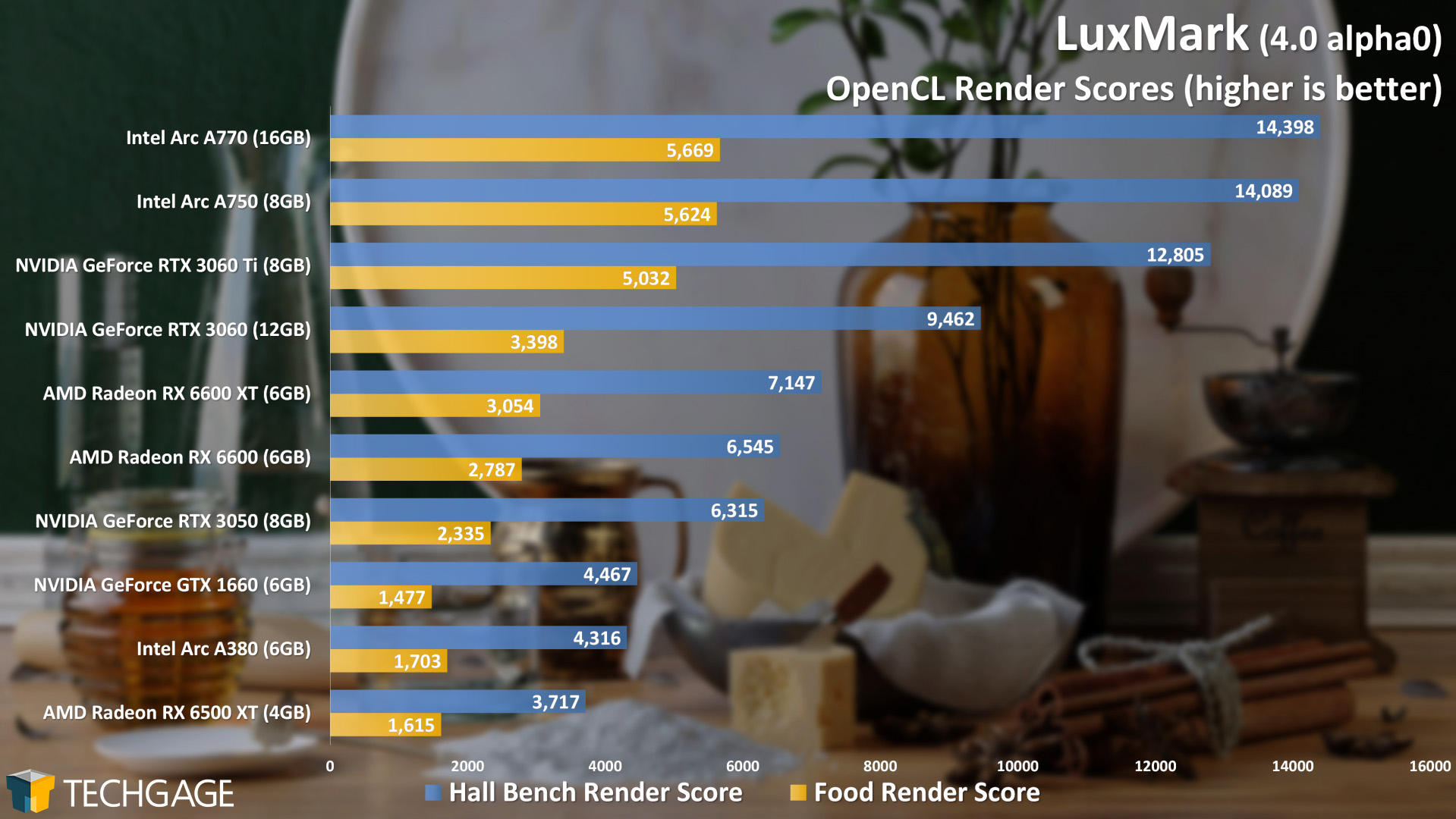- Qualcomm Launches Snapdragon 4 Gen 2 Mobile Platform
- AMD Launches Ryzen PRO 7000 Series Mobile & Desktop Platform
- Intel Launches Sleek Single-Slot Arc Pro A60 Workstation Graphics Card
- NVIDIA Announces Latest Ada Lovelace Additions: GeForce RTX 4060 Ti & RTX 4060
- Maxon Redshift With AMD Radeon GPU Rendering Support Now Available
A Creative Arc By Intel: A750 & A770 GPU Workstation Performance Review
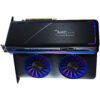
We recently took an in-depth look at Intel’s low-end Arc A380 graphics card in creator workloads, and now, we’re able to add the top-end A750 and A770 models to the results. We found some notable highlights of Arc with our A380 look, and as it happens, Arc 7 has created even more.
Page 1 – Arc A750 & A770: Introduction, Encoding & Rendering
Arc! The Herald Alchemists sing!
Following on the launch of the first Arc desktop release in early June, Intel has finally rolled-out Alchemist’s top-end models – A750 and A770. The wait for these has been so long, that despite sinking so much time into testing them over the past week, we’re not sure if their existence has truly sunk in yet.
Launch content for new generation GeForces and Radeons often involves so much new information, that it’s impossible to cover it all up front. Imagine, then, the launch of an entirely new GPU series from a third vendor – it’s downright overwhelming.
As has become Techgage norm, we’re kicking off our coverage of these new Intel GPUs with a focus on creator workloads. We’ll tackle the gaming angle later, as well as some features we wanted to test, but weren’t able to before embargo lift.
The amount of testing and retesting we performed while preparing this review is almost ridiculous, but it’s not to a fault of the Arc cards. When AMD and NVIDIA release new GPUs, it’s not usually hard to guess where a new model will fall into place, but with an entirely new vendor entering the arena, there’s no such luxury. Plus, game testing is one thing, but creation workloads can add an absurd amount of variability, so to be truly confident in our test data, a lot of sanity checking took place.
We’ve talked a lot about Intel Arc specs recently, but here’s another quick look at the current lineup:
| Intel’s Arc Gaming & Creator GPU Lineup | |||||||
| Xe Cores | Render Slices | GPU Clock | Memory | Bandwidth | TDP | SRP | |
| Arc A770 | 32 | 8 | 2.1 GHz | 16/8 GB 1 | 560/512 GB/s | 225W | $329 |
| Arc A750 | 28 | 7 | 2.05 GHz | 8 GB 1 | 512 GB/s | 225W | $289 |
| Arc A580 | 24 | 4 | 1.70 GHz | 8 GB 1 | 512 GB/s | 175W | $??? |
| Arc A380 | 8 | 2 | 2.0 GHz | 6 GB 1 | 186 GB/s | 75W | $139 |
| Arc A310 | 6 | 2 | 2.0 GHz | 4 GB 1 | 124 GB/s | 75W | $??? |
| Notes | 1 GDDR6 Arc AXXX = Alchemist |
||||||
The A770 LE ships with 16GB of memory (and has a $20 premium), but other versions will be made available with 8GB densities. As for the A580 and A310, Intel hasn’t revealed when those cards will officially launch, or what their prices will be. Both the A750 and A770 look to be a great value on paper, but it’s hard to ignore what extra you get with the A770 – twice the VRAM, and a 14% core count boost. NVIDIA’s RTX 3060 packs 12GB, and that seemed impressive enough at its release, and now we see Intel add 33% more to its Arc GPU at the same price-point.
With so much VRAM on offer on the top affordable Arc SKU, we hope that future generations will continue to include models with generous amounts of memory. If the performance is where people would like to see it, then Intel could carve a nice piece out of the creator market.
Since this is a graphics card review, let’s take a moment to ogle over Intel’s Limited Edition versions:
In a world where so many graphics cards can look downright garish, this simple all-black aesthetic is welcomed – and looks great here. In case a black front and back might have been too much, Intel’s applied a pattern to the backplate, and clear lettering to denote the model.
Both LE models require a 6- and 8-pin power connector, and while both might have gotten away with only a lone 8-pin (like our EVGA GeForce RTX 3060), the added power availability should help with overclocking. From what we understand, Arc is actually able to be overclocked a fair bit, but we have yet to be able to experiment with that ourselves.
While both of these cards look identical, a closer look at the A770’s power connector area reveals a covered header that an included cable for RGB control can be plugged into (the other end into a USB 2.0 header on the motherboard). Users will be able to tap into the lighting configuration via Cooler Master software.
We’re not going to waste much time before getting into a look at the performance of these new GPUs, but we did want to quickly cover some of Arc’s notable features – some of which we’ll be exploring more in the near-future in more detail.
With the Arc A380 launch a few months ago, Intel became the first vendor to offer GPU-accelerated AV1 video encoding, and that, along with super-strong HEVC performance, makes Arc alluring for video editors. Also included is XeSS (Xe Super Sampling), Intel’s take on upscaling derived from the fruits of deep-learning. A surprising number of games are available right now with XeSS support, including Shadow of the Tomb Raider, Death Stranding, and Arcadegeddon. More are coming soon, such as Hitman III and Ghostwire Tokyo.
In addition to XeSS, Arc also includes accelerated ray tracing capabilities, which isn’t unexpected, but is nice to see. The last thing (for now) worth mentioning is that Arc Control is Intel’s software solution of choice. Arc Control is meant to be a one-stop-shop for all GPU configuration and monitoring. In quick testing, we didn’t love the fact that it seems to operate only as an overlay, nor could we find an option to force disable VSync, but the design is tolerable. We do hope that the overlay aspect changes at some point, though – it’d be nice to be able to use Arc Control like a normal desktop application, and not have it disappear when you need to click outside of it.
One last thing before moving on; here’s a quick look at the Arc LE’s packaging, and a piece of swag we were given:
We ordinarily chuck swag into a corner without much thought, but we felt compelled to highlight this toolkit, as it’s actually a useful bit of swag. There are fourteen screwdrivers included, as well as an aesthetic that complements Arc nicely.
Alright, let’s get the show on the road.
| Techgage Workstation Test System | |
| Processor | AMD Ryzen 9 5950X (16-core; 3.4GHz) |
| Motherboard | ASRock X570 TAICHI (EFI: P4.80 03/02/2022) |
| Memory | Corsair Vengeance RGB Pro (CMW32GX4M4C3200C16) 8GB x 4 Operates at DDR4-3200 16-18-18 (1.35V) |
| AMD Graphics | AMD Radeon RX 6600 XT (8GB; Adrenalin 22.9.1) AMD Radeon RX 6600 (8GB; Adrenalin 22.9.1) AMD Radeon RX 6500 XT (4GB; Adrenalin 22.9.1) |
| Intel Graphics | Intel Arc A770 (16GB; Arc 31.0.101.3435) Intel Arc A750 (8GB; Arc 31.0.101.3435) Intel Arc A380 (6GB; Arc 31.0.101.3430) |
| NVIDIA Graphics | NVIDIA GeForce RTX 3060 Ti (8GB; GeForce 516.94) NVIDIA GeForce RTX 3060 (12GB; GeForce 516.94) NVIDIA GeForce RTX 3050 (8GB; GeForce 516.94) NVIDIA GeForce GTX 1660 (6GB; GeForce 516.94) |
| Audio | Onboard |
| Storage | Samsung 500GB SSD (SATA) (x3) |
| Power Supply | Corsair RM850X |
| Chassis | Fractal Design Define C Mid-Tower |
| Cooling | Corsair Hydro H100i PRO RGB 240mm AIO |
| Et cetera | Windows 11 Pro build 22000 (22H1) AMD chipset driver 4.08.09.2337 |
| All product links in this table are affiliated, and help support our work. | |
The benchmark results in this article build on those we delivered in our Arc A380 creator look last week. We added one extra benchmark, Adobe Lightroom, as we recently noticed that the JPG export function is now GPU-accelerated, and wanted to see how vendor performance differs. We’ll be building on top of these results for our upcoming GeForce RTX 4090 evaluation.
Encoding Performance
Video encoding has strengths for each vendor all over the place, so you really need to get rid of the noise and focus on the performance metric that matters most to you. As mentioned earlier, encode tests make it impossible to predict which GPUs will show the most strength, but thankfully for Intel, both Arc 7 cards perform great across all four graphs, with the A380 performing well in the transcode tests.
We managed to get VEGAS Pro tested for this article just in the nick of time, as our license expired in between testing the A750 and A770 – looking at the chart will tell you which one lost out! We’re going to be upgrading to VP20 for our next round of testing, so we’ll have a fuller performance picture before long. One thing’s clear, though: Intel’s Arc continues to be super-strong here.
If you took a look at our A380 performance report last week, you may remember that AMD failed the encode due to discoloration of the result. It turns out that’s due to a Radeon driver bug – one that doesn’t exist in the new Radeon PRO 22.Q3 driver. We swapped out the Adrenalin driver for that one for this test, and we’re glad we did, because we can see AMD too performs well here (which has been the case most of the time since we started testing VEGAS Pro). It’d be pretty sweet if driver upgrades stopped breaking things, though, and especially not keep them broken over multiple driver releases.
With our straight-forward transcode test in HandBrake, we continue to see that Arc is hard to beat in transcoding. The differences here are actually pretty stark. We’re just kicking ourselves for not yet being able to get AV1 encoding in. NVIDIA’s next GPUs will also have an accelerated AV1 encoder, so we hope to have the first comparative performance results in time for the green team’s upcoming embargo.
We’d be pretty happy if all encoding-type benchmarks scaled like BRAW Speed Test does here. The faster the GPU, the faster the decode performance. Here, Intel’s Arc 7 GPUs place just behind NVIDIA’s 3060 and 3060 Ti, and ahead of everything else.
We’ve been benchmarking Adobe’s Lightroom since the first version released, and until this point in time, we’ve never used it for GPU testing. That’s because in all of our previous testing, we’ve never noticed our export processes use it. Well, a change happened at some point, and it could have very well been a while ago, and we just didn’t notice because we use the same GPU in all of our CPU testing.
What’s clear from the above result is that exporting to DNG has nothing to do with the GPU whatsoever. We’re only including the result to make that point clear. Exporting to JPG can take great advantage of a GPU, and this becomes another test where Arc shines.
As the bottom five results show, Lightroom doesn’t support as wide a range of GPU hardware as we’d like to see. All of those 200 second results are the same because the work ended up being relegated to the CPU. No AMD GPU was able to help with the process, nor did the Arc A380 – which might possibly be the first driver-related bug we’ve encountered. But even NVIDIA’s GTX 1660 – a GPU a mere two generations old – failed to be utilized, as well. We hope Adobe will expand support in the future, because GPUs do speed up the JPG export process nicely.
Oct 5 Edit: The lack of GPU acceleration in Lightroom on the AMD side of things is due to another driver bug. The just-released 22.10.1 driver notes that this issue is fixed, so we’ll retest the Radeons in time for the RTX 4090 launch.
Because it really stands out, yes – the RTX 3060 Ti placed behind the RTX 3060. This is far from being the first time we’ve seen this sort of behavior from Lightroom, but it’s the first time to happen with GPUs involved. Months ago, we found that AMD’s Ryzen 9 5900X outperforms the 5950X – a result that has been oddly consistent even across generations.
Rendering Performance
We likely benchmark with Blender more than any other piece of software, thanks to the fact that it’s included in our CPU and GPU performance reviews, and also the subject of a quarterly deep-dive. If you’ve paid attention to any of those articles, you’ve no doubt noticed that AMD’s had a difficult time competing with NVIDIA, thanks largely to its use of dedicated ray tracing cores.
Blender release after Blender release, we’ve so rarely seen Radeon make a notable performance improvement. So imagine our surprise when we first noticed that Intel’s Arc cards leapt ahead of every single Radeon in each of the four Cycles tests. The roles are reversed with Eevee, however, with all three cards glued to the bottom.
This overall view really highlights the fact that AMD’s performance should be better than it is, and we do believe it will improve before long, as the company’s HIP API is continually being worked on. In time, HIP will also introduce RT acceleration, which should deliver a nice bump. Likewise, Intel will gain its own RT acceleration in a future release that will include an updated Embree engine – likely version 3.5.
On the topic of Embree, just look at the results here. LuxCoreRender utilizes Embree, but that’s been the case for years before Intel even announced its discrete GPU plans. Yet, at this launch, the performance crown belongs to Arc. The $289 A750 even manages to place ahead of the $399 RTX 3060 Ti. It’s interesting, though, that the A380 doesn’t enjoy the same kind of competitive performance. It only manages to slot alongside the older GTX 1660, but does keep ahead of the more expensive RX 6500 XT.
Support our efforts! With ad revenue at an all-time low for written websites, we're relying more than ever on reader support to help us continue putting so much effort into this type of content. You can support us by becoming a Patron, or by using our Amazon shopping affiliate links listed through our articles. Thanks for your support!




